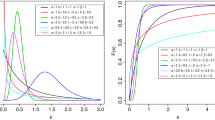Abstract
In the Bayesian approach, to describe a prior distribution on the set [0, 1] of all possible probability values, typically, a Beta distribution is used. The fact that there have been many successful applications of this idea seems to indicate that there must be a fundamental reason for selecting this particular family of distributions. In this paper, we show that the selection of this family can indeed be explained if we make reasonable invariance requirements.
Access this chapter
Tax calculation will be finalised at checkout
Purchases are for personal use only
Similar content being viewed by others
References
Aczel, J., Dhombres, J.: Functional Equations in Several Variables. Cambridge University Press, Cambridge (1989)
Gelman, A., Carlin, J.B., Stern, H.S., Dunson, D.B., Vehtari, A., Rubin, D.B.: Bayesian Data Analysis. Chapman & Hall/CRC, Boca Raton (2013)
Gelman, A., Robert, C.P.: The statistical crises in science. Am. Sci. 102(6), 460–465 (2014)
Kock, K.R.: Introduction to Bayesian Statistics. Springer, Heidelberg (2007)
Nguyen, H.T.: How to test without p-values. Thail. Stat. 17(2), i–x (2019)
Page, R., Satake, E.: Beyond p-values and hypothesis testing: using the minimum Bayes factor to teach statistical inference in undergraduate introductory statistics courses. J. Educ. Learn. 6(4), 254–266 (2017)
Wasserstein, R.L., Lazar, N.A.: The ASA’s statement on p-values: context, process, and purpose. Am. Stat. 70(2), 129–133 (2016)
Acknowledgments
This work was supported by the Institute of Geodesy, Leibniz University of Hannover. It was also supported in part by the US National Science Foundation grants 1623190 (A Model of Change for Preparing a New Generation for Professional Practice in Computer Science) and HRD-1242122 (Cyber-ShARE Center of Excellence).
This paper was written when V. Kreinovich was visiting Leibniz University of Hannover.
Author information
Authors and Affiliations
Corresponding author
Editor information
Editors and Affiliations
Rights and permissions
Copyright information
© 2021 The Editor(s) (if applicable) and The Author(s), under exclusive license to Springer Nature Switzerland AG
About this chapter
Cite this chapter
Kosheleva, O., Kreinovich, V., Autchariyapanitkul, K. (2021). Why Beta Priors: Invariance-Based Explanation. In: Sriboonchitta, S., Kreinovich, V., Yamaka, W. (eds) Behavioral Predictive Modeling in Economics. Studies in Computational Intelligence, vol 897. Springer, Cham. https://doi.org/10.1007/978-3-030-49728-6_8
Download citation
DOI: https://doi.org/10.1007/978-3-030-49728-6_8
Published:
Publisher Name: Springer, Cham
Print ISBN: 978-3-030-49727-9
Online ISBN: 978-3-030-49728-6
eBook Packages: Intelligent Technologies and RoboticsIntelligent Technologies and Robotics (R0)




